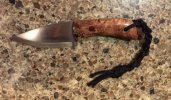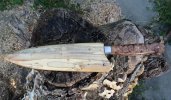Joe, the issue is that oil is not film building. Cured tung or teak oil "which is just tung oil with a little bit of varnish mixed in making it closer to a Danish oil" is so soft it can be picked away with a finger nail.
The simple fact is there are really no finishes you can apply to a knife that will really PROTECT the wood. The best you can hope for is make it more beautiful.
That's why knife makers use these incredibly hard, tough, oily or stabalized woods. Because they don't NEED protecting.
That's why I use a wax finish. When I make a handle out of kingwood or cocobolo or ironwood, I'm not trying to "protect" it when I finish it. I'm making it more attractive. With the possible exception of a thick layer of UV Cured polyurethane the wood is going to be orders of magnitude stronger than the finaih.
Everyone talking about shellac is referring to exotics woods used in decorative applications as boxes or decorative turned bowls. Not things that will be handled all day like knives.
What Greenberg says! I stabilize the wood first if it is a type that needs it or can be stabilized. That fills all the small pores and makes the wood stronger. Then when I sand I get a super smooth surface right up to 2000 grit. It would be useless to sand through 2000 with many unstabilized woods because the grit is way finer than the size of pores in the grain. You have to get all the scratches from the previous grit out before moving up to the next grit.
The final finishes like oils and waxes are just to make the grain pop a bit more and make it look even better. It doesn't protect the wood from a scratch, scuff, or bump.





